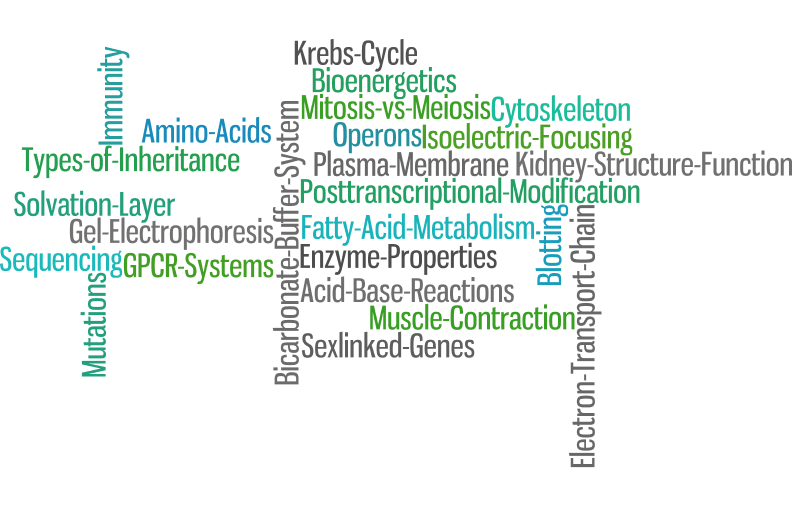When preparing for the MCAT, it’s important to identify topics that cut across content areas, because conceptual intersections between fields are (1) relatively likely to be high-yield topics and (2) help you integrate the material in a way that will allow you to apply the content flexibly in new contexts, as is often necessary for passage-based questions. Today, let’s focus on Le Châtelier’s principle, a topic that is usually studied as an isolated topic in general chemistry, but also shows up in a wide range of contexts involving chemistry, organic chemistry, and biochemistry. In this post, we’ll review Le Châtelier’s principle and show how it can apply in some unexpected contexts in the regulation of biochemical processes.
Let’s first review some basics:
All chemical reactions are in theory reversible, although some (like combustion) are not reversible in any practical sense. Equilibrium refers to the point where a chemical reaction stabilizes; more specifically, at equilibrium, reactants are being turned into products at the same rate that products are being turned into reactants. Note, however, that this does not mean that equal amounts of reactants and products are present. The equilibrium constant (K) is used to describe the degree to which a reaction favors products or reactants. Its formal definition is as follows: for a reaction aA + bB → cC + dD, K =[C]c[D]d/[A]a[B]b; while you should know this definition, you should also understand on a big-picture level that K is essentially a measure of the ratio of products to reactants. Large values of K mean that more products are present at equilibrium than reactants, K = 1 means that products and reactants are present in equal quantities, and K < 1 means that reactants are favored.
Le Châtelier’s principle describes what happens when something disturbs the equilibrium of a reaction. More specifically, it states that when the equilibrium conditions of a reaction are disturbed, the reaction will shift to compensate for that equilibrium. That’s a very general statement and it can be hard to see how that applies to concrete situations, so let’s work through an example. Let’s imagine an extremely simple reaction, in which X → Y, and to make the math easy let’s say that the equilibrium constant is 1 – that is, at equilibrium we have a mixture that is 50% X and 50% Y. Now let’s imagine that we have a laboratory technique that can remove Y from the reaction container, but that it doesn’t work at 100% efficiency. We apply this technique and remove half of the Y that is present. At this moment, we then have a mixture that is 75% X and 25% Y. In order to restore equilibrium, more X will have to be converted to Y. This explains why removing product pushes the reaction forward. In fact, if we were to repeat this process, we would convert all of X to Y! Correspondingly, if we were to add Y or remove X, we would push the reaction to the reactant side.
You can also think of energy and pressure as “reactants” that can be manipulated according to Le Châtelier’s principle. Let’s consider an exothermic reaction (i.e., one with a negative value of ΔH), and consider heat to be a product: A + B → C + D + heat. Increasing the temperature is equivalent to increasing the concentration of a product, which would push the process back to the reactant side. In contrast, keeping the reaction container cool would be like removing product, and would push the reaction forward. In reactions involving gases, reducing the pressure on the reaction container favors the side of the reaction with the most moles present, while increasing pressure favors the side with the fewer moles present. This tendency follows from the fact that 1 mole of gas occupies a constant volume (22.4 L at STP). A real-world application of this is the Haber process, in which ammonia is synthesized from elemental nitrogen and hydrogen, following the equation: N2 + 3 H2 → 2 NH3. The reactant side involves 4 moles of gas, while the product side has just 2 moles, so performing the reaction at very high pressures helps to favor the formation of ammonia despite the generally low reactivity of nitrogen and hydrogen gas.
A fundamental question in biochemistry
A fundamental question in biochemistry is how cells regulate the rate of crucial reactions, some of which may not be energetically favorable. Le Châtelier’s principle provides one way of making this happen. For example, let’s take the final reaction of the Krebs cycle, in which malate is oxidized to oxaloacetate. The equilibrium of this reaction actually favors malate, so we’re faced with the question of why the Krebs cycle doesn’t just grind to a halt here. The key to understanding this is to think about what happens to oxaloacetate. As soon as oxaloacetate is formed, it is swept up in the first step of the Krebs cycle, in which oxaloacetate and acetyl-CoA are combined to form citrate in a highly favorable, effectively irreversible reaction. This is just like the situation we discussed above in which the product Y was removed from the reaction container, pushing the reaction X → Y to completion. Regulating the concentration of products and reactants, which ultimately means leveraging Le Châtelier’s principle, is one of the major ways in which cells control important reactions.
In addition to biochemistry, having a solid grasp of Le Châtelier’s principle also pays dividends in studying acid-base chemistry, especially as applied to the behavior of amino acids at various pH levels and the behavior of buffers. Even more importantly, Le Châtelier’s principle provides important lessons about how to study technical content in a way to maximize your chances of MCAT success: understand the big picture and try to develop the ability to explain big concepts in simple words, look for connections between subject areas, and think about how a familiar principle can be applied in less-familiar contexts like those that occur in research-based passages.


